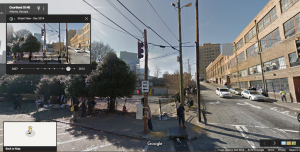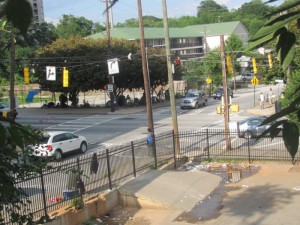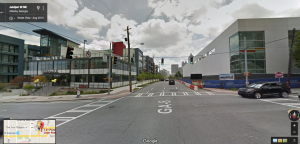Attending school in downtown Atlanta has opened my eyes to the city’s developing wealth gap. The city consists of pockets of rich and poor areas. Living here has encouraged me to discover new routes to get to my destinations. The first time I came across the intersection of Pine street and Courtland street, I was on the way home from Publix on Piedmont. I took Courtland to get back, and it hit me that this intersection looked completely different from the surrounding areas. My observations lead me to research this area and conclude that the built environment surrounding the intersection of Pine Street and Courtland Street can be seen as an area that discriminates against different classes. Gentrification is a term that can be used to describe this area because large amounts of homeless people are being pushed out of the redeveloped locations that are undergoing massive increases in property values, into the secluded intersection. The gentrification present in the intersection is resulting in marginalized communities that shift the community’s culture, places those affected farther into poverty, while also putting these individual’s public health in danger.
I remember observing about 15- 20 people along the sidewalk of the intersection, some had huge bags and others had nothing but the clothes on their back. The intersection was covered in garbage, and two nearby parking lots were completely empty. Observing the intersection made me question a lot of things like- how did the environment get to this condition? why were there nice houses on the other side of Courtland St.? And why weren’t there any stores nearby? Every time I went on Courtland and passed this intersection I noticed more and more things. I noticed that Metro Atlanta’s Task force for the homeless was right up the street and that it was strange that there was no street sign. Although there was a traffic light, there was no sign indicating the street was on Pine St. or Courtland St. I also observed two empty parking lots with rusty, bent gates that look like they haven’t been replaced in years. Some of these things I noticed can be seen with Google maps.
Google Maps provides satellite images of the intersection from October 2007 to August 2015. You can see exactly how the area has transformed in the last 7 years.

Homeless people surround this environment because of the homeless shelter on Pine Street. Metro Atlanta’s Task Force for the Homeless is a shelter that has “programs that help link people to services that include but are not limited to: shelter, permanent housing, transportation, employment and health care” and “The Task Force pursues progressive, enduring social change while respecting the urgent needs of homeless persons needing immediate and emergency assistance toward the goal of “no person left outside.” This information can be found on their website (click here) under the ‘Mission and History’ tab. Metro Atlanta’ Task Force for the homeless’ website provides information on its purpose, programs and services, donations, and even volunteering. As I went through the website, I found information posted on the site that included recent news regarding the shelter. While I was briefly surfing through the site, it is was apparent to me that the information has not been updated; the last article written was in July 2015. When I googled the homeless shelter, I found an article(click here) that announced that the City of Atlanta was battling for the shelter to be shut down in Georgia’s Supreme Court. The article states that because of missed payments from the shelter a foreclosure must be in order. The article stated, “the Georgia Supreme Court Monday gave the Metro Atlanta Task Force for the Homeless Inc. the right to have a jury decide whether the foreclosure sale of its shelter at Peachtree and Pine streets was illegal.” This case proves that gentrification exists. The city of Atlanta is attempting to shut down the shelter to make room for urban renewal which brings in more income to the city, but they are taking these actions at the cost of the homeless. By pushing out the homeless, they are placing these civilians further into detrimental conditions which only makes poverty a bigger issue in the city.
The conditions of the environment that the homeless people are living in are almost unimaginable. The proximity and density of the population makes sickness a more prevalent issue amongst them. Though the homeless shelter does what it can to provide medical care, people aren’t getting the proper medical attention they need. For example, a person could get sick and pass their sickness along to someone else through a form of close interaction and, ultimately, no one ends up getting treated for the illness. This makes the area a hub for disease. On top of that, the intersection is covered in filth. There is trash all over the floor and full trash cans on each side. In addition, living on the streets is difficult. Some people can not even get access to a proper shower, or a place to perform basic, necessary hygiene routines. The fact that the population of the area is increasing does not help. The marginalization of the less fortune continues to grow all whilst this happens. The homeless people that station in this area are excluded from society and pushed aside. This form of gentrification appeals to the shift in the community’s culture and puts a danger on public health.
Increasing government profit at the cost of lower class civilians is what the government does to achieve gentrification. Right down the street on Ponce De Leon and Courtland, there are numerous stores within the area, unlike the intersection between Pine and Courtland. The government seems to be more concerned about making a profit than the social well-being of their lower class citizens. Ponce De Leon and Courtland St. is also surrounded by luxury apartments. 131 Ponce is a luxury apartment complex that’s located only 3 blocks from the intersection of Pine and Courtland. It has huge glass windows and looks very elegant. On their website, they promote one bedroom apartments ranging from $1289-$1869, which is seemingly expensive(click here). I observed the area some more. I Google mapped Ponce and Courtland and viewed it on satellite images. The picture below shows Ponce and Courtland in October 2007 and August 2015 (click here).
The images of this intersection shows how much this area has changed and become more urban in 7 years . Gentrification is the reason for this change. The government wants to increase their revenues to raise the city’s attractability to prospect buyers and tourists. Just like Courtland and Pine, the image of the intersection of Ponce and Courtland has an empty parking lot and an old building. This proves that what happened there could very much happen to Pine and Courtland. The people that crowd Pine and Courtland are in danger of being pushed out due to the city’s selfish desires to revamp and urbanize the area. Not only is the city risking the health and survival of the homeless civilians, but they are altering the homeless’ community culture for the worse. The government breaks apart communities by using the idea of gentrification. Some of the less fortune in this area have built ties to those in similar situations, but this trend helps separate them .
Gentrification shifts the culture of the area making it more urbanized. The intersection at Pine street and Courtland street clearly depicts Atlanta’s marginalization towards the poor in centralized locations. The homeless people of this intersection are left with nowhere to go if the trend continues and urbanization of this area occurs. The intersection is only surrounded by a homeless shelter; no convenient store and no fast food restaurants. This area is already giving signs of gentrification by excluding people from nearby places. As a whole, the civilians of Atlanta must counteract the efforts the city is making to break apart an already broken area. It is up to us to stop gentrification from progressing into a trend that dominates the povertous regions in our city and help the homeless excel.


